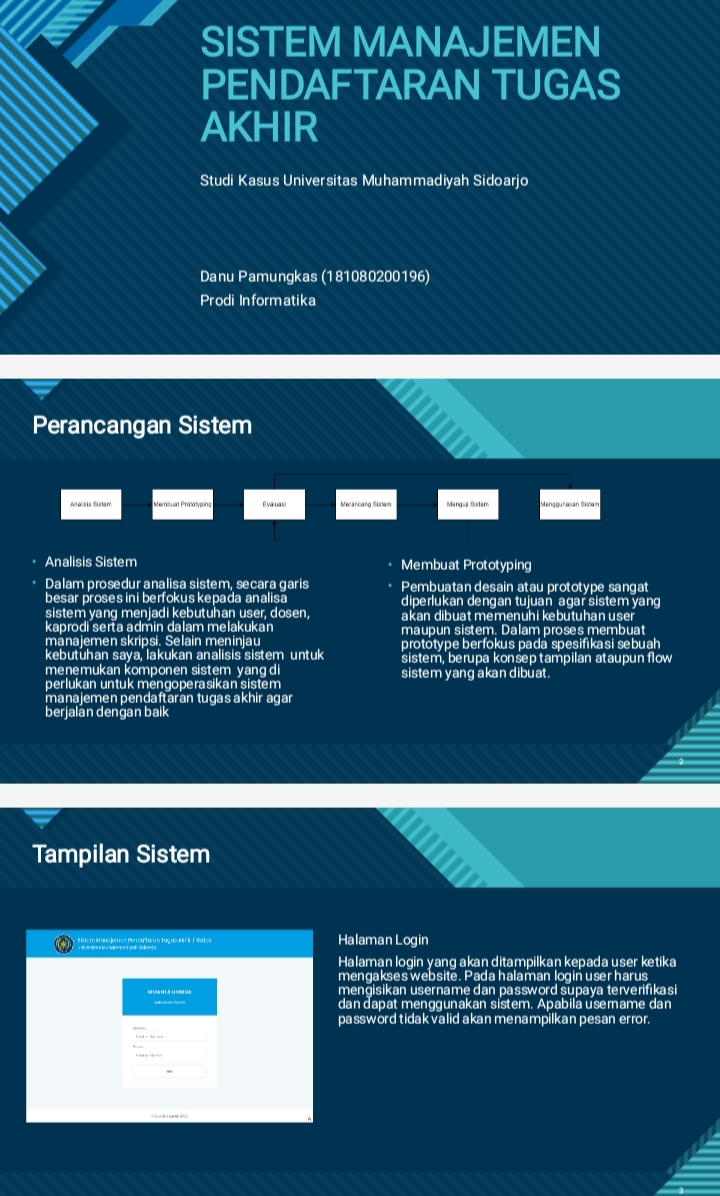Final Project Registration Management System (SIMANTA) [Case Study : University of Muhammadiyah Sidoarjo]
Sistem Manajemen Pendaftaran Tugas Akhir (SIMANTA) [Studi Kasus : Universitas Muhammadiyah Sidoarjo]
DOI:
https://doi.org/10.21070/pels.v2i2.1247Keywords:
Final Project Registration Management System, Information System, UMSIDA JournalAbstract
Muhammadiyah University of Sidoarjo is one of the private universities that provides final assignments and theses as one of the graduation requirements for obtaining Diploma and Bachelor degrees. The Final Assignment Registration Management System (SIMANTA) makes it easy for lecturers, students and admins to manage thesis data and provide information about the stages of the final project and thesis procedure for students. The development of this system was carried out to evaluate the existing system, namely SIMS UMSIDA. The previous system was still less than optimal in the procedures carried out in the implementation of the thesis because it was only used for the informatics study program. Therefore, with SIMANTA it can be used for all study programs and can distinguish data from each study program. The system design method in this study uses the prototype method and the data collection stage uses observation and interview techniques. The technology used for the SIMANTA design uses the Codeigniter version 4 framework, the PHP programming language version 7.4 and Bootstrap version 4x. So that the results of this study, the final assignment registration management system (SIMANTA) aims to provide convenience, manage data and provide information about thesis for lecturers, admins, and students at Muhammadiyah University of Sidoarjo.
Downloads
References
S. Lena, “Perancangan Dan Implementasi Sistem Manajemen Proposal Skripsi (Studi Kasus Jurusan Manajemen Informatika Politeknik Negeri Sambas),” Klik - Kumpul. J. Ilmu Komput., vol. 8, no. 1, p. 73, 2021, doi: 10.20527/klik.v8i1.373.
F. S. Suwita, “Pengembangan Sistem Informasi Tugas Akhir dan Skripsi (SIMITA),” J. Teknol. dan Inf., vol. 10, pp. 71–82, 2020, doi: 10.34010/jati.v10i1.
I. Pangaribuan and F. Subakti, “Sistem Informasi Akademik Berbasis Web pada SMK (Sekolah Menengah Kejuruan) Teknologi Industri Pembangunan Cimahi,” J. Teknol. dan Inf., vol. 9, no. 2, pp. 128–137, 2019, doi: 10.34010/jati.v9i2.1836.
R. Fauzan, “ONLINE PADA DIVISI AKADEMIK DAN KEMAHASISWAAN UNIVERSITAS PENDIDIKAN INDONESIA UNIVERSITAS KOMPUTER INDONESIA,” 2011.
S. N. Yanti and E. Rihyanti, “Penerapan Rest API untuk Sistem Informasi Film Secara Daring,” J. Inform. Univ. Pamulang, vol. 6, no. 1, p. 195, 2021, doi: 10.32493/informatika.v6i1.10033.
D. Purnomo, “Model Prototyping Pada Pengembangan Sistem Informasi,” J I M P - J. Inform. Merdeka Pasuruan, vol. 2, no. 2, pp. 54–61, 2017, doi: 10.37438/jimp.v2i2.67.
S. C. Eso, “Rancang Bangun Sistem Informasi Penerimaan Peserta Didik Baru (PPDB) Berbasis Web Dengan Menggunakan PHP dan MySQL,” 2010.
M. Arman, “Rancang Bangun Pengamanan FTP Server dengan Menggunakan Secure Sockets Layer,” J. Integr., vol. 9, no. 1, p. 16, 2017, doi: 10.30871/ji.v9i1.272.
L. Afuan, “Pemanfaatan Framework Codeigniter dalam Pengembangan Sistem Informasi Pendataan Laporan Kerja Praktek Mahasiswa Program Studi Teknik Informatika Unsoed,” Juita, vol. I, no. 2, pp. 39– 44, 2010, [Online]. Available: http://jurnalnasional.ump.ac.id/index.php/JUITA/article/view/413.
E. Usada, Y. Yuniarsyah, and N. Rifani, “Rancang Bangun Sistem Informasi Jadwal Perkuliahan Berbasis Jquery Mobile Dengan Menggunakan PHP Dan MySQL,” J. INFOTEL - Inform. Telekomun. Elektron., vol. 4, no. 2, p. 40, 2012, doi: 10.20895/infotel.v4i2.107.




